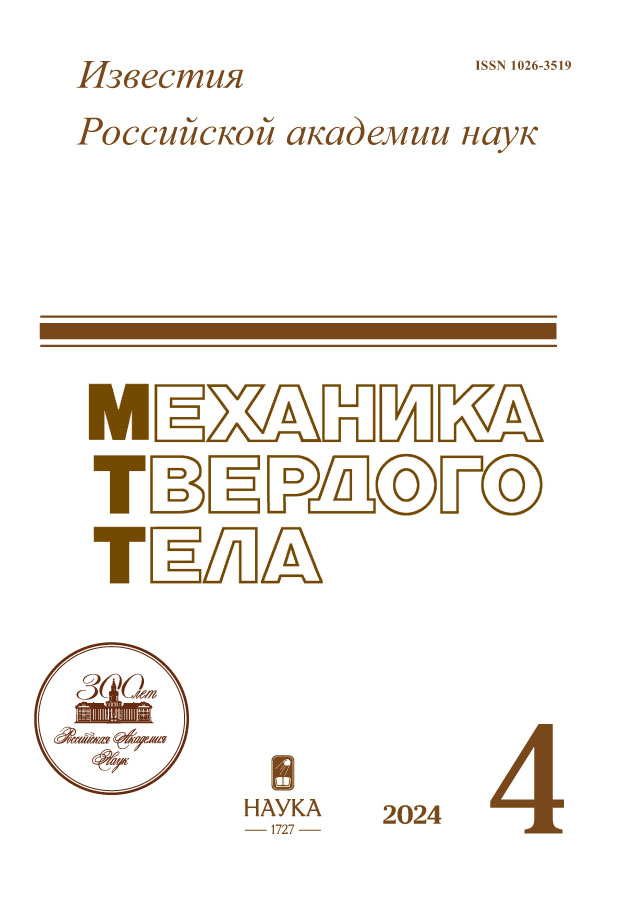Relaxation processes close to the surface of the impacts tress application caused by the pulse electron beam
- Authors: Morozov V.A.1, Ivanov V.S.1, Kats V.M.1
-
Affiliations:
- St. Petersburg University
- Issue: No 4 (2024)
- Pages: 90-102
- Section: Articles
- URL: https://transsyst.ru/1026-3519/article/view/673015
- DOI: https://doi.org/10.31857/S1026351924040069
- EDN: https://elibrary.ru/UCUETS
- ID: 673015
Cite item
Abstract
The paper presents outcomes of the study of short-timed shock action of the pulse electron beam on the aluminum obstacle. Analysis of the generation of the stress wave near the loaded surface based on the experimental data is provided. It is proved that wave generation in this case in contrast to theaction of laser beam takes place inside material in the area governed by the depth of electrons invasion.Relaxationofthestress wave starts from the boarder of this area. It was established that strongly non-equilibrium processes are take place in this relaxation area causing dramatic change depending on the shock parameters of the velocity of the stress and strength waves compared theirs stationary values. It is underlined that relaxation process has solo-wave nature in spite of the high stress amplitude. Separation of the elastic and plastic stresses propagation takes place only after the end of relaxation process.
Keywords
Full Text
About the authors
V. A. Morozov
St. Petersburg University
Author for correspondence.
Email: v.morozov@spbu.ru
Russian Federation, St. Petersburg
V. S. Ivanov
St. Petersburg University
Email: st048035@student.spbu.ru
Russian Federation, St. Petersburg
V. M. Kats
St. Petersburg University
Email: v.kats@spbu.ru
Russian Federation, St. Petersburg
References
- Khantuleva T.A. Specific Features of Processes Far from Equilibrium // Mathematical Modeling of Shock-Wave Processes in Condensed Matter: From Statistical Thermodynamics to Control Theory Shock Wave and High Pressure Phenomena. Springer, 2022. P. 31–63. https://doi.org/10.1007/978- 981-19-2404-0_2
- Khantuleva T.A. The Shock-Induced Planar Wave Propagation in Condensed Matter. // Mathematical Modeling of Shock-Wave Processes in Condensed Matter: From Statistical Thermodynamics to Control Theory Shock Wave and High Pressure Phenomena. Singapore: Springer, 2022. P. 209–249. https://doi.org/10.1007/978-981-19-2404-0_7
- Petrov Y.V., Utkin A.A. Failure-Delay Effect under Influence Pulse Dynamic Loads. // Mech. Solids. 2022. V. 57. P. 75–85. https://doi.org/10.3103/S0025654422010125
- Sudenkov Yu.V., Filippov N.M., Ronzhin O.F., Nedbai A.I. Action of the loading rate on perfornamnce of the elastic-vicious-plastic media (in Russian) // Pisma v ZhTF. 1980. V. 6. № 18. P. 1102–1105.
- Sudenkov Yu.V. Relaxation of elastic constant of aluminum close to the surface of the impact stress (in Russian) // Pisma v ZhTF. 1983. V. 9. № 23. P. 1418–1422.
- Wood D. On Longitudinal Plane Waves of Elastic-Plastic Strain in Solids // J. Appl. Mech. 1952. V. 19. № 4. P. 521–525. https://doi.org/10.1115/1.4010552
- Kanel G.I., Razorenov S.V., Utkin A.V., Fortov V.E. Shock-wave effects in condensed media. (in Russian). M.: Yanus-K, 1996. 407 p.
- Baizakov O.D., Morozov V. A., Sudenkov Yu.V. Model of elastic wave dumping (in Russian). In: Gazodinamika i teploobmen. V. 9: Dynamics of homogeneous and non-homogeneous media. L.: Leningrad University Publishing, 1987. P. 187–191.
- Morozov V.A., Sudenkov Yu.V. Generation and evolution of pulse stresses in solid bodies with respect to relaxation processes close to the surface of the impact stress application (in Russian). In: Fizicheskaya mekhanika. V. 6. Dynamic processes in gases and solid bodies. L.: Leningrad University Publishing, 1990. P. 150–159.
- Meshcheryakov Yu.I., Morozov V.A. On interaction of pressutre waves initiated with high-current pulse electron beam in solid body (in Russian) // Zhurnal tekhnicheskoi fiziki. 1979. V. 49. № 9. P. 1982–1986.
- Galiev Sh.U., Babich Yu.N., Zhurakhovskii S.V., Nechitailo N.V., Romashchenko V.A. Numerical simulation of wave processes in bounded media. (in Russian). Kyiv: Naukova dumka, 1989. 200 p.
- Kanel G.I. Shock waves in physics of solid state (in Russian). M.: Fizmatlit, 2018. 208 p.
- Oswald R.B., McLean F.B., Schalhorn D.R., Buxton L.D. One‐ Dimensional Thermoelastic Response of Solids to Pulsed Energy Deposition // J. Appl. Phys. 1971. V. 42. P. 3463–3473. https://doi.org/10.1063/1.1660755
- Morozov V.A., Bogatko V.I. Elastoplastic Wave Formation in a Near-Surface Region under Short-Term Loading // Dokl. Phys. 2008. V. 53. № 8. P. 462–465. https://doi.org/10.1134/S1028335808080144
Supplementary files
















